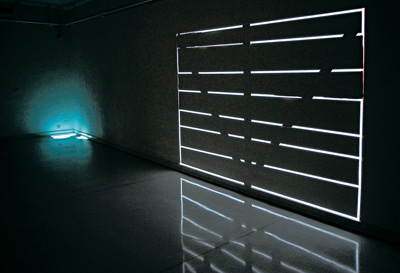| Umělec 2008/1 >> Martin Sedlák | Просмотр всех номеров | ||||||||||||
|
|||||||||||||
Martin SedlákUmělec 2008/101.01.2008 Jan Zálešák | profile | en cs de es |
|||||||||||||
|
Moravian Gallery, Brno, Pražák Palace Atrium, October 2007 – January 2008
I first encountered the objects of Slovak artist Martin Sedlák in the baroque granary at Klenova, where they were exhibited together with the finalists of the Startpoint 2005 prize. In a space in which I did not expect to encounter art, I was unexpectedly impressed by the light emanating from what appeared to be a boarded up window. Upon further scrutiny of the source of the light, I learned that the space “beyond” the wall was only an illusion created with light. Without using symbolism or attributing any literary meaning to his work, Sedlák’s Klenova installations awakened in the viewer (or at least in me) not only curiosity, but also something akin to a feeling of transcendence. Nevertheless, even reading his art as witty commentary requires exposure and openness to the artwork. In the Moravian Gallery the artist’s work isn’t as surprising. Four objects are layed out around a crepuscular, but not completely dark space. Two of them, Zorro 2 (2007) and Zorro 3 (2007), elaborate a motif present in Sedlák’s light installations from the beginning: doors that are both gates and gateways. Like the installation at Klenova, Sedlák uses technologically advanced material (electroluminescent foil) in combination with concepts from the outdoors and the agricultural. His motifs are amplified by evocations of the famous hero, Zorro. Zorro is like a medieval knight representing connections to both the high and the low, the gentile and the tough. For the generation that grew up with Hollywood blockbusters and the bravado of Antonio Banderas’ gesticulating sweeps, the combination of Zorro’s signature “Z” and the rustic stable provokes a light smile. The second set of objects has a similarly subversive character. (The two, lit puddles in the corner of the gallery, Accident (2006), unfortunately were not lit when I visited the exhibition, so I could only judge from the photo documentation on the Moravian Gallery web page). There is an illusion of naturalness that establishes a trompe l’oleil effect and leads to a contextual reading bolstered by the work’s title: the two radiant objects on the floor suddenly look like explicitly comical pictures of leaking nuclear material. In U Nimbu (2007), the artist uses a different technique. An illuminated belt is displayed, not mounted directly on the wall, but on an interior shadow eclipsing the supporting structure. Light glows from the “inside” and fills in the structure’s restricted space. The work’s title is once again fundamental to its reading. Nimbus is not merely an attribute; it is the core of the work. Moreover, it’s radiance gives meaning to the space inside the structure while leaving the center quite dark. Nimbus, with its symbolically empty frame (which in reality is just the gallery wall), can be appreciated as a typical contribution to the traditional vanitas theme. Understanding and interpreting Sedlák’s work prompts “reflexive” ideas such as the experience of light penetrating into dark space. As far as its magic and captivating charm, Sedlák’s use of light evokes feelings similar to those of “cleaner” light installations by the likes of Dan Flavin and Olafur Eliasson or, more locally, installations by Stanislav Zippe or Pavel Korbičky. Martin Sedlák’s bold handiwork nevertheless presents the character of his working process: folios are fixed to the walls with screws wherever it is necessary, and sometimes they are covered with cardboard. It could be said that the aforementioned “magic” of Sedlák’s installations is something like a side-effect on which he relies to contribute to the subtle irony of the whole installation.
01.01.2008
Рекомендуемые статьи
|
|||||||||||||








Комментарии
Статья не была прокомментированаДобавить новый комментарий